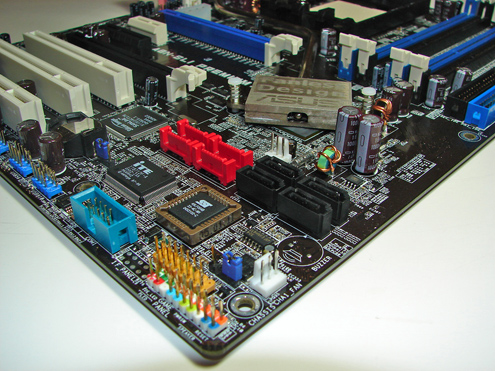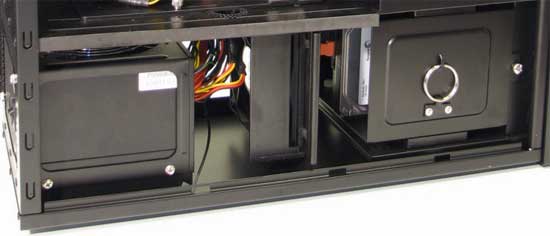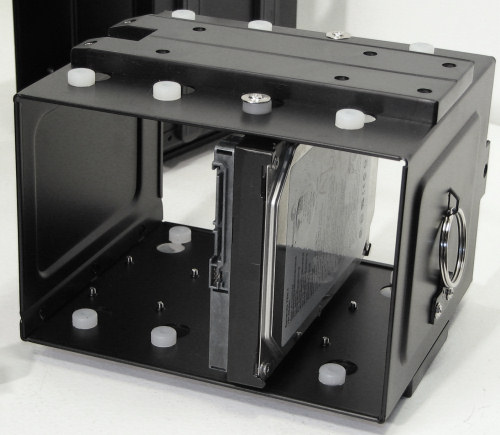A Lesson in User Failure: Investigating the Serial ATA Connector
by Ryan Smith on January 18, 2008 12:00 AM EST- Posted in
- Storage
SATA Anatomy, Failure Anatomy
It’s best to start first with a quick history lesson on the SATA design, as it hasn’t been static through the years. It has gone through some important revisions - some visible and some not – that have shaped the SATA connector in to what we see today. We’d also like to thank Knut Grimsrud, chairman of the SATA International Organization and Intel Fellow in their Technology & Manufacturing group for helping us out with this article and answering some of our questions.
First and foremost, the SATA-IO identified issues early on with the design of the SATA connector, and has revised it several times. This is most obvious in the move from the SATA 1 motherboard connector to the SATA 2 motherboard connector, where the SATA 1 motherboard connector was far more exposed than the SATA 2 connector. This switchover was particularly evident on boards using both native and external SATA controllers, where one would be SATA 2 compliant and the other SATA 1, requiring the different connectors.

The SATA 2 motherboard connector added shrouding around the connector, which significantly improved the durability of the connector as the shrouding prevented cables from easily bending the wafer part of the connector. Unfortunately this kind of shrouding couldn’t be added to SATA devices, because the standard was designed for use in small devices that don’t have clearance to fit a full shroud. This results in the modern half-shroud design for devices, where the top-half of the connector is shrouded by the device but not the bottom half.
The other significant changes in the standard since its inception have been latching and chamfering. Most SATA devices now have recesses in their top side shroud that allow barbs on SATA cables to latch in to in order to provide downward stability since the underside is the unshrouded side. Chamfering has been added to the square edges of the tongue, and while not a visibly dramatic change, we’ve been told this is one of the primary improvements in strengthening the SATA connector.
Yet in spite of these changes we’ve still managed to do something wrong and break the connector on our hard drive. For the reason why, we’ll start with case designs and cable designs.
Part of our problem can be attributed to the amount of space we have to work in with the case involved in this investigation, the Antec P182. The P182, like many other cases, doesn’t leave a lot of space behind the primary hard drive bay. For most cases this is because there are motherboard components and cards in the way, while with the P182 it’s a matter of a 120mm fan being located behind the hard drive bay, which helps pull air through the lower chamber. Either way, with this specific case, we measure that we have about 2” between the rear end of a hard drive and the fan, which is very little space to work in.

We then come to the cable, in this case it was a bog-standard cable that came with one of the products we’ve used over the years. As we mentioned earlier, SATA cables aren’t quite as flexible as PATA cables when it comes to longitudinal bending, and while we can technically bend a cable completely over at any location, this isn’t great because it causes the cable to pull back in to a more relaxed position. From the tip of the connector, the cable we measured needs about 2.5” of space to bend comfortably.

With the amount of clearance we have being less than the amount of space to need to ideally bend the cable, it becomes obvious that this will quickly become tricky. We need to bend the cable at a sharper angle so that it stays well clear of the fan, which means it’s going to be exerting some force on our hard drive, a generally acceptable but not ideal situation.
And then finally there is the layout of the P182’s hard drive bay. The P182 requires the hard drives to be installed in to the cage at an angle, such that they are on their sides with the bottom pointing towards the bottom of the case, which you can see here. Keep in mind the fact that the top hard drive is on the opposite side of the case from where the motherboard is.

In this combination, we have the anatomy of our failure. Our cable is putting force on the SATA data connector towards the bottom side, which as we covered earlier is the weaker direction to go because it’s not shrouded like the top side is. Furthermore we’re using a SATA-1 style cable without a latch, which means we don’t have said latch to reinforce the connection. It turns out that this is enough force to break the SATA data connector on our hard drive, and when the drive cage was being secured one day the connector broke.











62 Comments
View All Comments
jmvillafana - Friday, January 18, 2008 - link
It happened to me five years ago with the first motherboard I had with SATA option. Conector broke on the motherboard side. Having two HDD and two connectors I had no options, found the plastic piece and mended as you did. With luck and care, the board worked for four and a half years. A short life for a system, I never found out if the crippled connector shortened the life of the board. I actually unhooked and hooked the connector a few times through this time. My new systems have SATA connectors and I allways use latched ones.bobbozzo - Friday, January 18, 2008 - link
Due to the lack of space at the bottom of the p182 case, I put my 2 hard drives in the middle bay, above the floppy bay.I also moved the fan from the bottom (the PS has a fan, why should it need another?), to the front of the case in front of those 2 drives... they stay nice and cool now.
I broke a Molex power connector on a Deathstar once as it was too tight, and it the pins separated from the plastic and broke off the motherboard, from pulling the Molex connector STRAIGHT out as designed.
JonathanYoung - Friday, January 18, 2008 - link
Hi Mr. Smith,I would like to provide some constructive criticism on your article. There are some instances where you use "in to" when you should be using "into." For example: "that have shaped the SATA connector in to what we see today."
I am not a grammar expert but this is something that caught my eye a couple of times and I thought you'd like to know.
As for the content of the article, I think it is an excellent subject and something that many PC power users can relate to.
Thank you!
Jonathan Young
kilkennycat - Friday, January 18, 2008 - link
For example, take a look at the Antec P160 design and the hard-disk cage in that design, (including the hard-disk shock mounts). The hard-disks load sideways into that cage. All connectors are fully exposed for cable installation. And with the huge front-slots in the P160 (filtered) and a decent intake fan, the hard-disks are very nicely cooled. That 'up-side-down' P18x design with the power-supply at the bottom also has the doubtful virtue of requiring extra-long power-supply cables. And how many motherboards come with a set of right-angle SATA connectors anyway ?Pity the P160 seems to be out-of-production. Great that I have a new one stored in my attic for my next PC build. The 2 active thermal probes in the P160 with the associated front-panel display are a huge bonus in these days of hot CPUs and hot graphics cards. No need to run some silly temperature-monitoring program in the background. The P160 loads the motherboard on a tray... a very handy feature indeed when installing or troubleshooting. However, the tray depth is ATX --- a few of the latest 'way-out' enthusiast motherboards (e.g Asus "Striker") have a depth exceeding the ATX spec that would short out on the lip of the tray and collide with the tray fasteners.
peternelson - Friday, January 18, 2008 - link
Enjoyed the description of your experiences and it serves a useful reminder to take care with internal SATA cables.
I feel it would also be worthwhile to mention ESATA (the official external SATA standard) which has redesigned the connectors in view of external use. In particular external connectors will tend to get more abuse (strain of devices being relocated, re-matings, bending).
Since the internal SATA connector was known to have a potential to damage the device, rather than the cable when it snapped, the ESATA connector was redesigned so that ideally, when something breaks it is the cable connector (part of your relatively cheap cable) rather than the device connector (so you don't write off your expensive drive array).
Although some vendors tried to take SATA externally using the original connectors designed for internal use, the official external SATA specification addresses that problem deliberately (as well as better electrical noise immunity).
Thanks for the article.
Lonyo - Friday, January 18, 2008 - link
I managed to break the plastic bit on a 200GB hard drive by accidentally pressing the cable down while working on the innards.Luckily I was able to sort out a temp solution and get stuff off the drive, but that involved tape and cardboard, and currently the drive sits unused in a box.
Early SATA connectors were a giant pain. I've also had numerous occasions when the cable has come loose from either the motherboard or hard drive, due to cramped conditions and the relatively inflexible cables and poor retention at both ends.
Heidfirst - Friday, January 18, 2008 - link
I have had exactly the same experience as jasonnovak.I'm sure that I didn't put undue stress on the connector but nevertheless the tongue came away stuck in the cable.
On my drive it loooked to be held in place by a little tab/slot presumably with some adhesive - obviously not enough or it failed.
Anyway, the drive still works but I can only use it with that 1 cable so it's now hotglued together.
AlexWade - Friday, January 18, 2008 - link
When SATA first came out, I bought me a 250GB Seagate. Back when I bought it, 250GB was expensive because perpendicular recording wasn't even dreamed about. Anyway, while shifting it around, I broke the connector on the hard drive. Fortunately for me, I never removed the connector. I jury-rigged something. It ain't pretty, but it still works to this day. I found lying around one of those paint mixing paddles you get for free (and which quite often my dad used on me, balsa wood never hurt so much) and wedged it under the hard drive. It worked. And that hard drive is still a functioning member of society.jay401 - Friday, January 18, 2008 - link
I believe "immutable" means unchanging, and you want "immune" instead.
Starcub - Monday, August 10, 2009 - link
How did you get the quote feature to work? I get a pop up window asking me to type in the quoted text, which I do. When I click ok, the text box disappears, and no quote is inserted in my post...At least that makes me immutable to misquoting people ;P